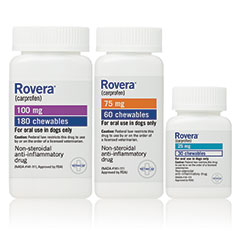
In addition to relieving pain and inflammation associated with arthritis, Rovera can also control the pain and inflammation caused by orthopedic and soft tissue surgeries such as spays and neuters in dogs.
Description
Rovera is an FDA-approved prescription medication. And only Rovera is backed by more than 12 years of research. In addition to treating arthritis pain, Rovera can also control the pain and inflammation caused by orthopedic and soft tissue surgeries such as spays and neuters in dogs. So don't give your best friend just any NSAID.
Rovera is a 24-hour, non-steroidal anti-inflammatory drug (NSAID). Your veterinarian may prescribe Rovera to relieve the pain and inflammation associated with arthritis, or to help control pain after soft tissue and orthopedic surgeries. Rovera is available in 25 mg, 75 mg, and 100 mg chewable tablets. The dosage is dependent upon your dog's body weight and can be administered either once or twice a day.
Before using Rovera, be sure to read this Important Safety Information.
About Arthritis
Understanding Arthritis in Dogs
Arthritis is a progressive, degenerative disease. This condition can affect one or more joints and can lead to pain, stiffness, joint swelling, lameness and reduced mobility, all of which can result in a reduced quality of life. That's why it's important for you to recognize the potential signs of a dog's arthritis pain, and notify your veterinarian so treatment can start early.
As the disease progresses, there can be additional destruction of cartilage on the bone surface, and production of extra bone around the joint. If properly treated, the progression can be slowed significantly allowing dogs to continue enjoying their favorite past times such as walking, running and swimming.
Know the Facts About Arthritis in Dogs
- Arthritis is one of the most common sources of chronic pain that veterinarians treat.1
- Arthritis affects as many as one out of five adult dogs in the U.S.2 And these are just the cases that have been diagnosed. The actual number of dogs suffering from arthritis is unknown because many dog owners attribute the subtle changes in their dogs to "old age" or "slowing down."
- While many cases of arthritis occur in older, overweight and larger breed dogs, the disease can affect dogs of all sizes, ages and breeds.
- With the exception of joint replacement, there's no cure for degenerative joint disease and arthritis in dogs. But the pain associated with these conditions, and the stiffness and lameness they cause, can be managed.
1. Gaynor, J et al. (Eds) 2003. The Essential Guide to Pain Management: A complete Resource for Veterinary Pain Management. Pfizer Inc., New York
2. Johnston SA Osteoarthritis: joint anatomy, physiology and pathobiology. Vet Clin N Am Small Anim Pract 1997;27:699-723
There's no reason for any dog to suffer from the pain and inflamation of arthritis. Pain can have a tremendous impact on your dog's quality of life. When your dog's in pain, he won't be as active. And that can lead to weight gain and additional stress on joints that are already sore. But when your dog feels less pain and is more comfortable, he will be more active, more fit, and more willing to participate in the family activities you love to do together.
Arthritis in Dogs: Signs & Symptoms
Unfortunately, dogs can't tell us where it hurts. In fact, they can't even tell us when it hurts. So sometimes it's difficult to know when your dog is in pain. What we do know is that dogs experience pain and discomfort the same way humans do. And dogs will hide pain, making diagnosis difficult.
Dogs display a wide variety of responses to pain:
- They may be violent and vocalize - or be quiet, withdrawn and inactive.
- They may be aggressive when approached, as they try to protect themselves from further pain, or they may be subdued or withdrawn.
- Their ears may lie flat against their head.
- They may lick the affected area.
The key is to look for a change in your dog's behavior. Because arthritis is a progressive condition that manifests itself over time, the signs of pain become more apparent as the condition becomes more severe.
- General decrease in activity or exercise
- Reluctance to walk, run, climb stairs, jump or play
- Stiffness or decreased movement of joints
- Limping or lameness
- Difficulty rising from a resting position
- Lagging behind on walks
- Soreness when touched
- Yelping or whimpering in pain
- Acting aggressive or withdrawn
- Exhibiting other personality changes
If you notice any of these changes, see your veterinarian. The sooner the condition is recognized, the sooner your dog will feel less pain and become active again.
FAQs
Vethical Rovera (carprofen): Frequently Asked Questions
Dog Owner Information about Rovera® Chewable Tablets (pronounced “Ro‑ver‑a;”) for Osteoarthritis and Post-Surgical Pain
This summary contains important information about Rovera. You should read this information before you start giving your dog Rovera and review it each time the prescription is refilled. This sheet is provided only as a summary and does not take the place of instructions from your veterinarian. Talk to your veterinarian if you do not understand any of this information or if you want to know more about Rovera.
What is Rovera?
Rovera is a nonsteroidal anti-inflammatory drug (NSAID) that is used to reduce pain and inflammation (soreness) due to osteoarthritis and pain following surgery in dogs. Rovera is a prescription drug for dogs. It is available as a chewable tablet and is given to dogs by mouth. Osteoarthritis (OA) is a painful condition caused by inflammation which results in “wear and tear” of cartilage and other parts of the joints that may result in the following changes or signs in your dog:
- Limping or lameness
- Decreased activity or exercise (reluctance to stand, climb stairs, jump or run, or difficulty in performing these activities)
- Stiffness or decreased movement of joints
To control surgical pain (e.g. for surgeries such as spays, ear procedures or orthopedic repairs) your veterinarian may administer Rovera before the procedure and recommend that your dog be treated for several days after going home.
What kind of results can I expect when my dog is on Rovera?
While Rovera is not a cure for osteoarthritis, it can relieve the pain and inflammation of OA and improve your dog’s mobility.
- Response varies from dog to dog but can be quite dramatic.
- In most dogs, improvement can be seen in a matter of days.
- If Rovera is discontinued or not given as directed, your dog’s pain and inflammation may come back.
- Studies have shown that dogs that receive long term Rovera treatment for osteoarthritis show progressive improvement over time.
Who should not take Rovera?
Your dog should not be given Rovera if he/she:
- Has had an allergic reaction to carprofen, the active ingredient of Rovera.
- Has had an allergic reaction to aspirin or other NSAIDs (for example deracoxib, etodolac, firocoxib, meloxicam, phenylbutazone or tepoxalin) such as hives, facial swelling, or red or itchy skin.
Rovera should be given to dogs only. Cats should not be given Rovera. Call your veterinarian immediately if your cat receives Rovera. People should not take Rovera. Keep Rovera and all medicines out of reach of children. Call your physician immediately if you accidentally take Rovera.
How to give Rovera to your dog.
Rovera should be given according to your veterinarian’s instructions. Your veterinarian will tell you what amount of Rovera is right for your dog and for how long it should be given. Most dogs will take Rovera Chewable Tablets right out of your hand or the chewable tablet can be placed in the mouth. Rovera may be given with or without food.
What to tell/ask your veterinarian before giving Rovera.
Talk to your veterinarian about:
- The signs of OA you have observed (for example limping, stiffness).
- The importance of weight control and exercise in the management of OA.
- What tests might be done before Rovera is prescribed.
- How often your dog may need to be examined by your veterinarian.
- The risks and benefits of using Rovera.
Tell your veterinarian if your dog has ever had the following medical problems:
- Experienced side effects from Rovera or other NSAIDs, such as aspirin
- Digestive upset (vomiting and/or diarrhea)
- Liver disease
- Kidney disease
- A bleeding disorder (for example, Von Willebrand’s disease)
Tell your veterinarian about:
- Any other medical problems or allergies that your dog has now or has had.
- All medicines that you are giving your dog or plan to give your dog, including those you can get without a prescription.
Tell your veterinarian if your dog is:
- Pregnant, nursing or if you plan to breed your dog.
What are the possible side effects that may occur in my dog during Rovera therapy?
Rovera, like other drugs, may cause some side effects. Serious but rare side effects have been reported in dogs taking NSAIDs, including Rovera. Serious side effects can occur with or without warning and in rare situations result in death. The most common NSAID-related side effects generally involve the stomach (such as bleeding ulcers), and liver or kidney problems. Look for the following side effects that can indicate your dog may be having a problem with Rovera or may have another medical problem:
- Decrease or increase in appetite
- Vomiting
- Change in bowel movements (such as diarrhea, or black, tarry or bloody stools)
- Change in behavior (such as decreased or increased activity level, incoordination, seizure or aggression)
- Yellowing of gums, skin, or whites of the eyes (jaundice)
- Change in drinking habits (frequency, amount consumed)
- Change in urination habits (frequency, color, or smell)
- Change in skin (redness, scabs, or scratching)
It is important to stop therapy and contact your veterinarian immediately if you think your dog has a medical problem or side effect from Rovera therapy. If you have additional questions about possible side effects, talk to your veterinarian.
Can Rovera be given with other medicines?
Rovera should not be given with other NSAIDs (for example, aspirin, deracoxib, etodolac, firocoxib, meloxicam, tepoxalin) or steroids (for example, cortisone, dexamethasone, prednisone, triamcinolone). Tell your veterinarian about all medicines you have given your dog in the past, and any medicines that you are planning to give with Rovera. This should include other medicines that you can get without a prescription. Your veterinarian may want to check that all of your dog’s medicines can be given together.
What do I do in case my dog eats more than the prescribed amount of Rovera?
Contact your veterinarian immediately if your dog eats more than the prescribed amount of Rovera.
How should Rovera Chewable Tablets be stored?
Keep Rovera Chewable Tablets in a secured storage area out of the reach of your dog and other pets. If your dog ingests more than your veterinarian prescribed, or if your other pets take Rovera Chewable Tablets, contact your veterinarian right away.
What else should I know about Rovera?
This sheet provides a summary of information about Rovera. If you have any questions or concerns about Rovera or osteoarthritis pain, or postoperative pain, talk to your veterinarian. As with all prescribed medicines, Rovera should only be given to the dog for which it was prescribed. It should be given to your dog only for the condition for which it was prescribed. It is important to periodically discuss your dog’s response to Rovera at regular check ups. Your veterinarian will best determine if your dog is responding as expected and if your dog should continue receiving Rovera.
To report a suspected adverse reaction call 1-800-916-8305.



